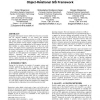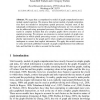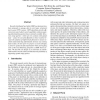112
Voted
ERCIMDL
2000
Springer
15 years 4 months ago
2000
Springer
The OASIS (Ontologically Augmented Spatial Information System) project explores terminology systems for thematic and spatial access in digital library applications. A prototype im...
124
click to vote
CIKM
2000
Springer
15 years 4 months ago
2000
Springer
Geographic Information Systems (GISs) have become an essential tool for efficient handling of our natural and artificial environment. The most important activities in a GIS are qu...
113
click to vote
ADBIS
2000
Springer
15 years 4 months ago
2000
Springer
A number of algorithms of clustering spatial data for reducing the number of disk seeks required to process spatial queries have been developed. One of the algorithms is the scheme...
GECCO
2006
Springer
15 years 4 months ago
2006
Springer
Spatial based gene selection for division of chromosomes used by crossover operators is proposed for three-dimensional problems. This spatial selection is shown to preserve more g...
90
Voted
EDBTW
2006
Springer
15 years 4 months ago
2006
Springer
Abstract. In recent times, the proliferation of spatial data on the Internet is beginning to allow a much larger audience to access and share data currently available in various Ge...
84
Voted
DIAGRAMS
2006
Springer
15 years 4 months ago
2006
Springer
We argue that a comprehensive model of graph comprehension must include spatial cognition. We propose that current models of graph comprehension have not needed to incorporate spat...
98
Voted
COMPSAC
2004
IEEE
15 years 4 months ago
2004
IEEE
Recently distributed hash table (DHT) mechanisms have been proposed to manage data in very large, structured peer-to-peer (P2P) systems. DHT algorithms provide efficient exact-mat...
GIS
1992
ACM
15 years 4 months ago
1992
ACM
A new approach to representing qualitative spatial knowledge and to spatial reasoning is presented. This approach is motivated by cognitive considerations and is based on relative ...
98
Voted
CIKM
1994
Springer
15 years 4 months ago
1994
Springer
In a spatial database, an object may extend arbitrarily in space. As a result, many spatial data structures e.g., the quadtree, the cell tree, the R+-tree represent an object by p...
VL
1994
IEEE
15 years 4 months ago
1994
IEEE
Though visual access to spatial database systems has attracted much attention in recent years, there have only few deductive visual languages for spatial information systems been ...






